|
The road out of Townsville was just as bad as the road in, but the day was warm and sunny and the breeze was at our backs so we were not complaining. We stopped in at the Coca-Cola Amatil bottling factory just north of town and Karen presented a letter of introduction from her former boss at Coca-Cola South Pacific. Karen was able to send an e-mail to her friends at work in Sydney, and we also received a large bottle of drink each. We could have taken even more had we been able to carry it, a lesson we would remember a couple of months further down the track.
After about fifty kilometres of cycling under an increasingly hot sun, Karen and I sheltered underneath a bridge for lunch before riding on to the Big Crystal Creek camping area of Mount Spec national park. We nodded hullo to a couple of caravanners, the only other residents of the campground when we arrived in mid-afternoon, and were invited over to their van for a cup of tea and some biscuits. Paul and Thelma were South Australians, from Lucindale in the south-east corner of the state, and we got on with them very well. After a while we left to set up our tent, collect firewood from a supply provided by the National Parks, and walk over to Paradise Pool, a lovely swimming hole only a short distance from the camping area.
We shared our campfire with Paul and Thelma that night, watching the moon rise through the trees and a couple of possums search the campground for scraps. A couple of guys from a group of four who pulled into Crystal Creek shortly before dark joined us soon after. They were both nicely inebriated (pissed as farts) and left after half an hour, probably because nobody wanted to talk to them. Our evening broke up around ten o'clock, but the night was young for our four drunken neighbours who drank and played guitar, both very well, until just before dawn.
In the morning Paul and Thelma invited us on a day trip up onto the range to Paluma. It was a trip we would never have done by ourselves, as it involved a climb of about a thousand metres up twenty two kilometres of narrow and winding bitumen road. Bird-wise, it was a simply magic day, beginning with two new birds at a morning tea stop at Little Crystal Creek and two more on a rainforest walk at Paluma. A stop at the Ivy Teahouse for a Devonshire tea added another two birds to our list, both relatively rare and excellent additions to our total. The Macleay's Honeyeater and the Victoria's Rifle-bird are both found only in small areas of far northern Queensland, but at the teahouse they were impossible to avoid. When Thelma noticed the rifle-bird on a nearby table, she pointed it out to us, and a Macleay's Honeyeater landed on her outstretched finger! In all, Karen and I saw seven new birds - absolute heaven!
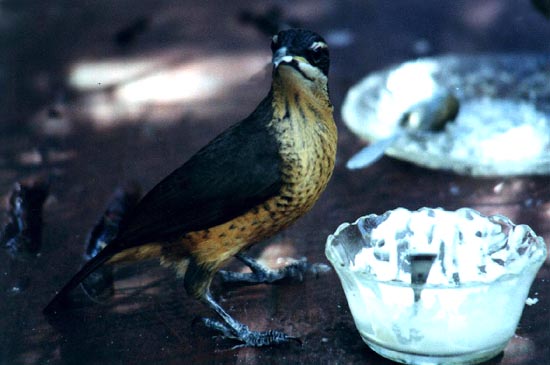
Female riflebird getting into cream at Paluma tea-house
At the end of the day, Paul and Thelma joined us again after dinner for a fireside chat in the light of the full moon. A small possum with a deformed front paw called around to our campsite looking for food and sympathy. He received neither from Karen, who treated him unmercifully and soon had him scurrying away to seek a safer handout.
Because the next day would only be a short hop of thirty kilometres to Jourama Falls, I spent an hour in the morning fitting and calibrating Karen's new cycle computer. We exchanged addresses and said our goodbyes to Paul and Thelma, braved four kilometres of bad dirt and corrugations and two kilometres of old highway before reaching a decent surface, arriving at our next campsite before lunch. In the afternoon we wandered up the creek to a lookout over the very impressive falls. Karen had a skinny dip in a rock pool on the way back, and that was pretty impressive as well. Shortly before returning to our tent, we saw a northern fantail, a new bird that we had been expecting to see for some time, but which had somehow been eluding us.
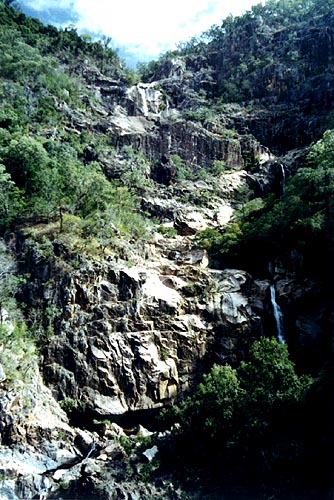
Jourama Falls
We rose early the next morning for birdwatching up and down the creek, rewarded with a terrific view of a male and female shining flycatcher, two totally dissimilar birds. They are both beautiful, but surprisingly, it is the female which is the more colourful. The male is jet black all over, while the female only has black plumage on the top and back of its head, its underparts being white and its wings, back and tail a bright, rich, rufous chestnut.
Back on the road, a strong tailwind soon helped us to Ingham. On a previous visit to Ingham Karen and I had spent a very weird night at the local caravan park. The manageress, a woman with a strange, witch-like appearance had lived in a caravan with God knows how many cats who, judging by the smell, had not been completely house-trained. The amenities block had been awful - dirty, decrepit and home to many spiders, insects and amphibians. I had used the toilet once, but only out of desperation, and Karen had shared her toilet and shower with families of green tree frogs. We would be unable to repeat the experience, however, as the park had been closed down. To make up for my disappointment, Karen graciously allowed me to buy some Kentucky Fried Chicken, formerly a major proportion of my diet, but not indulged in since Sydney. It was great, as always, and easily topped my highlights list for the day.
At a lookout over Hinchinbrook Island and the channel separating it from the mainland, I noticed my back tyre was beginning to shred and bulge. I hoped it would last until we arrived at Cardwell, our next destination. We arrived without incident at 3pm, after a day of eighty three kilometres, and immediately booked a water taxi ride to the northern end of Hinchinbrook and a water taxi and bus trip back to Cardwell from the southern end.
We then booked a site at the caravan park at the northern end of town. It was pretty expensive, but did provide a covered area, campers kitchen, television and lights. Karen and I had hoped to leave our bikes at the caravan park while we spent five days walking the Thorsburn Trail on nearby Hinchinbrook Island, but the manageress of the park did not want the responsibility of looking after our bikes. She is now highly placed on our list of dickheads, and not just because she would not store our bikes. We stayed at her park for a week, on and off, and every time I went up to pay her for another day, she behaved like she was doing me a huge favour by dragging herself into the office and taking my money from me. She did not crack a smile the entire time we were at her park.
Our neighbours at the caravan park were Neville and Louise and their two kids, Elise and Alana. Over a couple of beers, courtesy of Neville, we explained our predicament and were immediately offered a solution to our bike storage problem. Nev and Louise were on holiday from Darwin, doing day trips in the area fossicking for precious stones and metals, and would be in the caravan park for at least a week while awaiting the arrival of relatives, so they offered to look after Elle and Mel for us. Karen and I were unaware at the time that Neville and Louise would play a major role in our travels, not just for the time we were on Hinchinbrook, but during the next couple of years as well.
The next day, a Sunday, was spent shopping and preparing for the hike. I also checked out the location of the bike shop (hardware store) which unfortunately was closed. My rear tyre was completely shot and I had been hoping to buy - or at least order - a replacement before we left for the Hinchinbrook hike. We were up early the next day to pack up the tent and our sleeping gear and to stow the bikes under the annex of Neville and Louise's tent next door. While Karen stayed at the jetty with our gear, I walked to the bike shop to check the availability of tyres.
Our tyres, and the tubes they contained, were a constant source of concern. We were always checking them. If we were planning on riding that day, as soon as I got out of the tent in the morning I would feel all four tyres on the bikes to see if they needed air or repair. And they needed repair often. At the local hardware store and bike shop, when I tried to buy a 700C tyre, which I had been assured are available in every outlet all around Australia, I found they only stocked twenty seven and twenty eight inch sizes. "That's funny," I thought, "I could have sworn Australia moved to the metric system about twenty years ago ..."
The store manager thought that a twenty seven inch tyre was the same as a 700C, but he said he would check with his supplier while we were away and let me know on Thursday when we were scheduled to return from Hinchinbrook. If necessary, I could order a 700C then, as they restocked their shop from Townsville on Fridays.
Back at the jetty, Karen and I boarded the Sea Spray for a bumpy ride through a rolling swell to the Cape Richards Resort on the northern tip of Hinchinbrook. A strong southerly wind was whipping across the channel, and the Sea Spray lived up to its name. From the resort, we were directed to a five kilometre self-guided rainforest walk and told we would be picked up again from North Shepherd Beach in Macushla Cove at the end of the walk. From the beach pickup we were taken via Missionary Bay to the "Mysterious Mangrove Everglades" (according to a tourist brochure) where we were unloaded onto a boardwalk for a short stroll to the back of Ramsay Bay Beach and the start of the Thorsburn Trail.
Because of its popularity and the resultant damage to the trail and campsites, the walk down the east coast of Hinchinbrook, world renowned as one of the best walks in Australia, is now strictly controlled by the NPWS. Pre-booking and payment are essential, numbers are limited, the walk can only be done in one direction and camping areas are spaced so as to encourage a set itinerary. Karen and I have no problems with the regulation of natural walks - we have seen the damage that has been done by unregulated walks elsewhere.
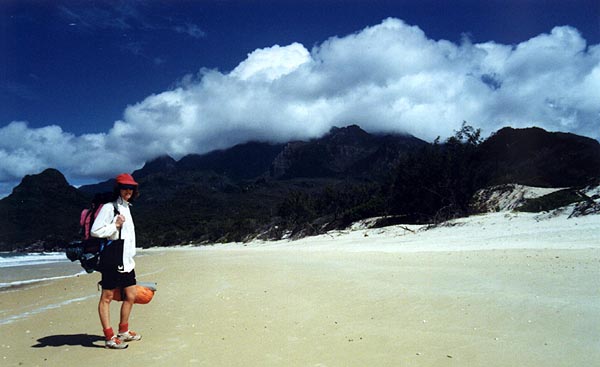
Karen on the beach on Hinchinbrook Island
We were carrying our gear in an almost identical manner to our Fraser Island walk. The first day, shortened because of the morning's travel arrangements, involved a walk down the beach to a saddle below Nina Peak for photographs north and south, a descent to Nina Bay, another walk along the beach before rock-hopping over a couple of small headlands to another beach walk along Boulder Bay, and another ridge traverse to our first night campsite by the lagoon at the northern end of Little Ramsay Bay. We camped next to three guys from Melbourne - Andrew, John and their former teacher Bob - who had just returned from a three day climb of the island's highest point, Mount Bowen. The NPWS literature on the walk spoke of the need to protect food from the ravages of native rats, so we hung our supplies from fishing line strung between trees. We only saw a couple of rats, and they were no problem which was a welcome respite from the possums and brush turkeys on the mainland.
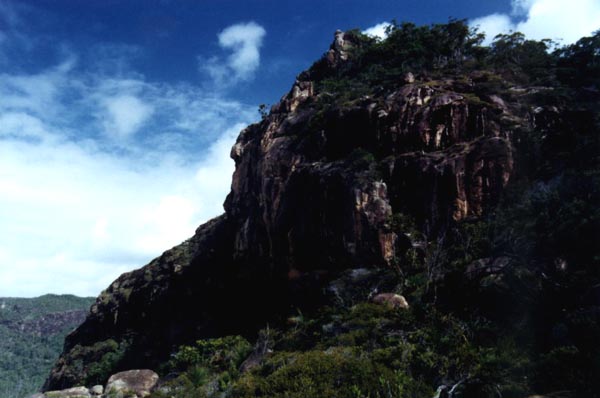
Part of Nina Peak
The second day began with rain. Low cloud obscured all of the major peaks along the spine of the island. The trail was similar to the first day, beach walking, low rocky headlands and inland sections through forest, rainforest and mangroves. We crossed numerous creeks, with North Zoe Creek being the most popular. Everyone stopped here to have their photograph taken next to the crocodile warning sign, before heading off to our next stop at South Zoe Creek.
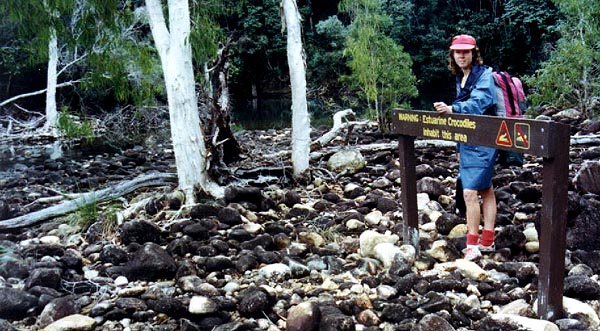
Karen and the crocodile warning sign
Apart from two hours spent in a side trip up to Zoe Falls for a cool and rainy dip in the plunge pool, Karen and I spent most of the afternoon talking to Andrew as he painstakingly attacked a coconut with a Swiss Army pocket knife. I warned him to be very careful, as every movement of the blade rekindled memories of my little accident at Lake Awoonga and tightened my sphincter muscle accordingly. Two hours after it had begun, the coconut peeling was complete, and we shared some of its milk and pulp.
At around 5:30pm the weather showed signs of clearing, so everyone trooped out of their shelters under the rainforest canopy, made their way out onto the beach, checked out the views of the mountain tops and then scurried back into the dark as the rain began again. It continued all night, but eased in the morning, though the wind continued to shake water from the trees onto our tents. By the time we were ready to pack up, however, the day had turned out dry, but still overcast.

Above Zoe Falls
We said goodbye to the three Melbourne guys who were headed north, and proceeded up to the top of Zoe Falls for great views over Zoe Bay. The creek led up to a saddle - at two hundred and sixty metres this was the high point of the walk. Near the top Karen and I spotted a yellow, black and white wren-like bird which we would have to identify on our return to Cardwell, where we had left our bird book. It would prove to be a yellow breasted boatbill, another new bird. We lunched atop rocks beside Diamantina Creek, then walked the last kilometre for the day across a hill with good views south to Lucinda before descending to the campsite near Mulligan Falls.
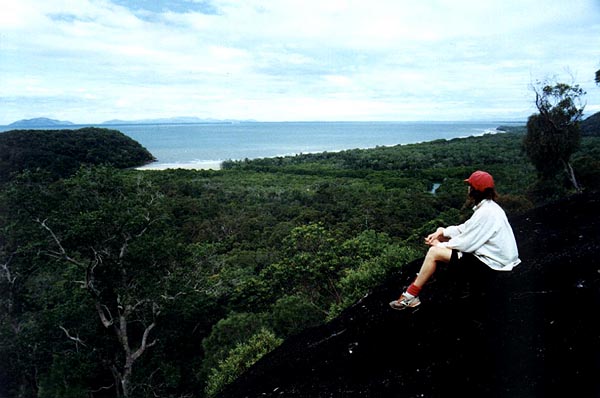
Above Mulligan Creek
Rainforest campsites tend to be dark, wet and muddy, and this was no exception. We erected the tent and left it to hopefully dry while we ventured down to the plunge pool for a swim. As usual, I did my macho dive-into-the-freezing-water routine, while Karen performed her pre-immersion ritual of testing the water with a toe, standing ankle deep in the shallows for a minute or two, moving forward until the water reaches her knees, her thighs, and finally her waist, and then with a mighty gasp of determination, she sinks into the water until just her head is showing. Only then will she actually start to swim. Karen has been known to dive into a pool only about three times in her adult life.
While waiting for Karen, I had explored every nook and cranny of the pool. I had swum almost up to the base of the falls, but had been forced back by the volume of water that cascaded down the rock face and surged out into the pool through a smooth, narrow chute. At its entrance I climbed up onto a rock ledge to wait for Karen. Waiting for Karen is one of the things I do best in the world, primarily because I have had so much practice at it. Eventually Karen entered the water and swam into the start of the chute. She was reaching down with a foot, trying to find a rock to stand on, when she screamed, and cried out to me, saying that she had been bitten by something. I scrambled down to the water's edge as Karen clambered out of the water, a twenty millimetre gash on the side of her right foot near the toe beginning to bleed copiously. I helped her to a comfortable rock and raced back to the tent for our first aid kit.

Karen and Mulligan Falls
When I returned, Karen dressed the wound, swearing that something had reached up from the bottom of the pool and bitten her. While not totally disbelieving, I preferred to believe that Karen was suffering from typical female hysteria, and had simply cut her foot on a piece of glass or a sharp rock. Creatures from the bottom of the black lagoon were just not on my agenda.

Karen's bloody foot
In the evening, we walked along the track south of the camping area looking for birds. We spotted some Macleay's Honeyeaters and a Victoria's riflebird, our first sightings of them in the wild (as opposed to the environment at the teahouse in Paluma). We were both thrilled by our first sighting of a Noisy Pitta, a really good tick. From somewhere in the understorey of the rainforest came a series of strange sounds, but despite a long and painstaking search, we were never able to discover what was making the calls. In fact, it was not until early 1999, when reading the diary entry for this day again, that Karen and I both realised that the bird had been an orange footed scrub fowl, first seen earlier on Whitsunday Island.
Fast moving rats scuttled around our feet as we prepared and ate dinner, and the darkness of the rainforest ensured a fairly early night. A few showers overnight cleared away in the early morning for our walk to Mulligan Bay Beach via about five creek crossings, and a five kilometre slog into the wind along the beach down to George Point. Rain set in about halfway along the beach, but the sighting of three beach curlews brightened the day considerably. We beachcombed and birdwatched after arriving at our pickup point a couple of hours prior to the appointed hour. There followed a short but rough ride in a punt across the water to Lucinda, then a bus ride back to Cardwell. Surprisingly, on a stretch of road that we had cycled over and found reasonably interesting, Karen and I both fell asleep in the bus.
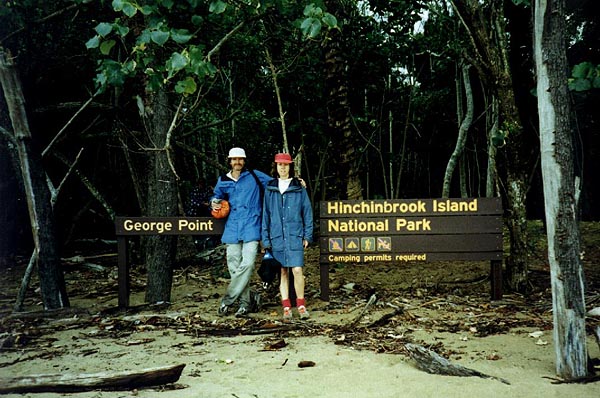
Waiting for our pickup from George Point
Back in Cardwell, I walked down to the hardware store while Karen carted our gear back to the caravan park. The manager said that the Townsville bike shop thought that twenty seven inch tyres were the same as 700C tyres, so I walked back to the caravan park, retrieved my bike from under Neville's and Louise's annex, rode back into town and tried fitting a twenty seven inch tyre to my back wheel. It was too large, so I refitted my old tyre and asked Scotty, the shop assistant, to try to get a 700-35C tyre when he was in Townsville in the morning.
We had dinner with Neville and Louise and two French backpackers, and watched a show on successful Aussies. Both Karen and I dined on plenty of eye candy because Elle and Mel were both featured. Even better was a hot shower at the end of the day. The entire Friday was spent waiting for Saturday, as Scotty and his supplies did not arrive back from Townsville until after dark on Friday night. Next morning we said our goodbyes to Neville and Louise, making sure we got their address as a visit to Darwin was definitely on our agenda. Scotty had been unable to get a 700-35C tyre (thirty five millimetres wide) but had acquired a 700-38C (thirty eight millimetres wide). Beggars can't be choosers, and I was soon fitting the tyre to my back wheel outside the front of the hardware store.
My belief that tyres would be available everywhere on the east coast, and that we would therefore not need to carry a spare had been found wanting. With the clarity of twenty-twenty hindsight, it would have been prudent to have bought two tyres in Cardwell, but we had cycled blindly and innocently on towards Mission Beach, Innisfail, and a date with the Palmerston Highway.
|









